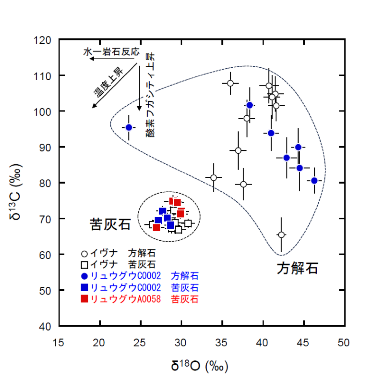Joint Press Release
Shogo Tachibana (Professor, Department of Earth and Planetary Science)
Takeshi Iizuka (Associate Professor, Department of Earth and Planetary Science)
A research team led by Associate Professor Wataru Fujiya of the Graduate School of Science and Engineering, Ibaraki University, Associate Professor Noriyuki Kawazaki and Professor Hisayoshi Yurimoto of the Graduate School of Science, Hokkaido University, Professor Tetsuya Yokoyama of the Department of Earth and Planetary Science, Graduate School of Science, Tokyo Institute of Technology, and Professor Shogo Tachibana of the Graduate School of Science, University of Tokyo, has analyzed samples from the asteroid Ryugu samples recovered by the Hayabusa2 spacecraft, and have elucidated the evolution of oxygen concentrations and gas molecular species present on Ryugu.
In this study, we examined the abundance ratios of carbon and oxygen isotopes in the carbonate minerals (calcite and dolomite) in Ryugu’s samples. The results showed that the isotope ratios of both carbon and oxygen in calcite varied greatly among the different particles, while those in mafic calcite varied little. These results suggest that calcite formed early in the alteration process at Ryugu, when temperatures and oxygen concentrations were rising and the fraction of gas species was changing, while the calcite was formed at higher temperatures and with a relatively high fraction of carbon dioxide in the gas, while the system was in equilibrium.
Such isotopic compositions of carbonate minerals have not been reported in previous meteorite studies. This suggests that Ryugu and its meteorite parent bodies were composed of different materials and evolved in unique environments.

The results were published online in Nature Geoscience on Wednesday, July 10, 2023.
For more information, please see
Graduate School of Science web: https://www.s.u-tokyo.ac.jp/ja/info/8544/
Publication URL: https://www.nature.com/articles/s41561-023-01226-y

